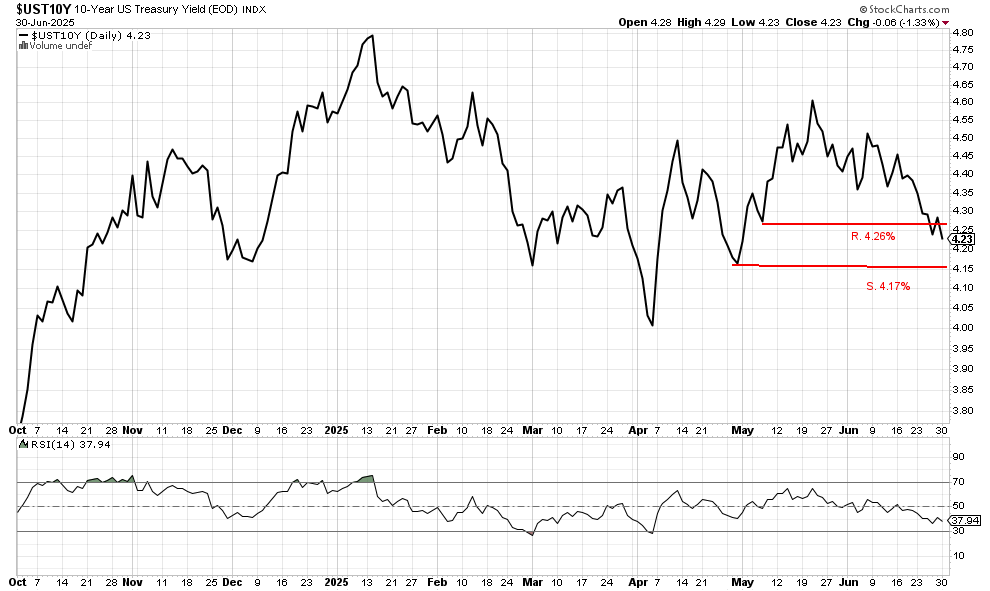Morning Brief

Headline News:
The stock market is on track for a modestly lower opening, with S&P 500 futures down 16 points or 0.3% below fair value.
The projected slower opening comes after yesterday’s strong showing in which several mega-cap stocks pushed to new all-time highs, and in turn boosted the S&P 500 and NASDAQ Composite to record highs.
The market awaits the final amendments to the large reconciliation bill, as the Senate continues its “vote-a-rama” with a House vote expected on Wednesday. Republicans are considering lowering the debt ceiling to win the support of Senator Rand Paul. Notably, the bill has been stripped of an amendment that sought to bar state regulation of AI for the next ten years.
In other macro-related news, Financial Times reports that the Trump administration is considering narrowing trade deals in order to avoid imposing new tariffs on July 9.
Fed Chairman Powell will take part in a discussion at the European Central Bank’s conference in Sintra, Portugal at 9:30 ET.
Today’s economic data will include the release of the final S&P Global U.S. Manufacturing PMI (prior 52.0) at 9:45 ET, followed by May Construction Spending (Briefing.com consensus -0.2%; prior -0.4%), May job openings (prior 7.391 mln), and June ISM Manufacturing Index (Briefing.com consensus 48.8%; prior 48.5%) at 10:00 ET.
Treasuries are on track for a higher start with the 10-year yield falling four basis points to 4.19%.
(Michael Gibbs, Managing Director, Lead Portfolio Manager)
Markets:
The S&P 500 rallied for a third consecutive session, closing at a new all-time high of 6,204.95. The RSI index also reached a new high, confirming the strength of the rally and suggesting potential for further upside. However, the index is now entirely outside the upper Bollinger Band, which typically signals overbought conditions and could lead to near-term selling pressure.
Key support levels to watch include the prior breakout level at 6,147.43 and the 20-day moving average at 6,029.95.
On the macro front, the 10-year Treasury yield declined below the resistance level at 4.26% and is currently trading at 4.21%, reflecting a supportive backdrop for equities as bond yields retreat.
We are currently Intermediate-term bullish and short-term bullish.


John N. Lilly III CPFA
Accredited Portfolio Management Advisor℠
Accredited Asset Management Specialist℠
Portfolio Manager, RJFS
Partner, DJWMG
Windsor Wealth Planners & Strategists
Futures trading is speculative, leveraged, and involves substantial risks. Investing always involves risk, including the loss of principal, and futures trading could present additional risk based on underlying commodities investments.
The Relative Strength Index (RSI), developed by J. Welles Wilder, is a momentum oscillator that measures the speed and changes of price movements.
The percentage of stocks trading above a specific moving average is a breadth indicator that measures internal strength or weakness in the underlying index. The 50-day moving averages are used for short-to-medium-term timeframes, while the 150-day and 200-day moving averages are used for medium-to-long-term ones. Signals can be derived from overbought/oversold levels, crosses above/below 50%, and bullish/bearish divergences.
The Dow Jones Industrial Average (DJIA), commonly known as “The Dow,” is an index representing 30 stocks of companies maintained and reviewed by the editors of the Wall Street Journal. The Russell 2000 Index measures the performance of the 2,000 smallest companies in the Russell 3000 Index, which represents approximately 8% of the total market capitalization of the Russell 3000 Index.
The S&P 500 is an unmanaged index of 500 widely held stocks that is generally considered representative of the U.S. stock market. Past performance may not be indicative of future results. Keep in mind that individuals cannot invest directly in any index, and index performance does not include transaction costs or other fees, which will affect actual investment performance. Individual investors’ results will vary. Opinions expressed are those of the author, John N. Lilly III, and not necessarily those of Raymond James. “There is no guarantee that these statements, opinions, or forecast provided herein will prove to be correct. “The information contained was received from sources believed to be reliable, but accuracy is not guaranteed. Investing always involves risk, and you may incur a profit or loss. No investment strategy can guarantee success. The charts and/or tables presented herein are for illustrative purposes only and should not be considered as the sole basis for your investment decision. International investing involves special risks, including currency fluctuations, different financial accounting standards, and possible political and economic volatility. Investing in emerging markets can be riskier than investing in well-established foreign markets.
This is not a recommendation to buy or sell any company’s stock mentioned above.
US government bonds and treasury bills are guaranteed by the US government and, if held to maturity, offer a fixed rate of return and guaranteed principal value. US government bonds are issued and guaranteed due to the federal government’s timely principal and interest payment. Bond prices and yields are subject to change based on market conditions and availability. If bonds are sold prior to maturity, you may receive more or less than your initial investment. Holding bonds to term allows redemption at par value. There is an inverse relationship between interest rate movements and bond prices. Generally, when interest rates rise, bond prices fall, and when interest rates fall, bond prices generally rise.
The Nasdaq 100 (^NDX) is a stock market index made up of 103 equity securities issued by 100 of the largest non-financial companies listed on the NASDAQ. It is a modified capitalization-weighted index. It is based on exchange and not an index of U.S.-based companies.
The Russell 2000 Index is a stock market index that measures the performance of the 2,000 smaller companies included in the Russell 3000 Index. It is managed by London’s FTSE Russell Group and is widely regarded as a bellwether of the U.S. economy because it focuses on smaller companies that focus on the U.S. market.



